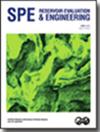An Extended Unified Viscoelastic Model for Predicting Polymer Apparent Viscosity at Different Shear Rates
IF 1.5
4区 工程技术
Q3 ENERGY & FUELS
引用次数: 9
Abstract
Polymer flooding is one of the most commonly used chemical enhanced oil recovery (EOR) methods. Conventionally, this technique was believed to improve macroscopic sweep efficiency by sweeping only bypassed oil. Nevertheless, recently it has been found that polymers exhibiting viscoelastic behavior in the porous medium can also improve microscopic displacement efficiency resulting in higher additional oil recovery. Therefore, an accurate prediction of the complex rheological response of polymers in porous media is crucial to obtain a proper estimation of incremental oil to polymer flooding. In this paper, a novel viscoelastic model is proposed to comprehensively analyze the polymer rheological behavior in porous media. This proposed model was developed and validated using 30 coreflooding tests obtained from the literature and further verified against a few existing viscoelastic models. The proposed viscoelastic model is considered an extension of the unified apparent viscosity model provided in the literature and is termed as extended unified viscoelastic model (E-UVM). The main advantage of the proposed model is its ability to capture the polymer mechanical degradation at ultimate shear rates primarily observed near wellbores. Moreover, the fitting parameters used in the model were correlated to rock and polymer properties using machine learning technique, significantly reducing the need for time-consuming coreflooding tests for future polymer screening works. Furthermore, the E-UVM was implemented in MATLAB Reservoir Simulation Toolbox (MRST) and verified against the original shear model existing in the simulator. It is worth mentioning that the irreversible viscosity drop for mechanical degradation regime was captured during implementing our model in the simulator. It was found that implementing the E-UVM in MRST for polymer non-Newtonian behavior might be more practical than the original method. In addition, the comparison between various viscosity models proposed earlier and E-UVM in the reservoir simulator showed that the latter model could yield more reliable oil recovery predictions as the apparent viscosity is modeled properly in the mechanical degradation regime, unlike UVM or Carreau models. This study presents a novel viscoelastic model that is more comprehensive and representative as opposed to other models in the literature. Furthermore, the need to conduct an extensive coreflooding experiment can be reduced by virtue of developed correlations that may be used to estimate model fitting parameters accounting for shear-thickening and mechanical degradation.预测不同剪切速率下聚合物表观粘度的扩展粘弹性统一模型
聚合物驱是最常用的化学提高采收率(EOR)方法之一。传统上,人们认为该技术通过只扫过的原油来提高宏观扫油效率。然而,最近研究发现,在多孔介质中表现出粘弹性行为的聚合物也可以提高微观驱油效率,从而获得更高的额外采收率。因此,准确预测聚合物在多孔介质中的复杂流变响应对于正确估计聚合物驱增油量至关重要。本文提出了一种新的粘弹性模型来综合分析聚合物在多孔介质中的流变行为。通过从文献中获得的30次岩心驱油试验,并与一些现有的粘弹性模型进一步验证了该模型。所提出的粘弹性模型被认为是文献中提供的统一表观粘度模型的扩展,并被称为扩展统一粘弹性模型(E-UVM)。该模型的主要优点是能够捕捉到聚合物在井筒附近的极限剪切速率下的机械降解。此外,模型中使用的拟合参数通过机器学习技术与岩石和聚合物性质相关联,大大减少了未来聚合物筛选工作中耗时的岩心驱油测试的需要。此外,在MATLAB油藏模拟工具箱(MRST)中实现了E-UVM,并与模拟器中存在的原始剪切模型进行了验证。值得一提的是,在模拟器中实现我们的模型时,捕获了机械降解体系的不可逆粘度降。研究发现,在MRST中实现E-UVM对聚合物非牛顿行为的研究可能比原来的方法更实用。此外,将之前提出的各种粘度模型与储层模拟器中的E-UVM模型进行比较表明,与UVM或Carreau模型不同,E-UVM模型可以在机械降解状态下正确地模拟表观粘度,从而得出更可靠的采收率预测。本研究提出了一种新颖的粘弹性模型,与文献中的其他模型相比,该模型更全面,更具代表性。此外,通过开发出的可用于估计考虑剪切增厚和机械退化的模型拟合参数的相关性,可以减少进行广泛的岩心驱油实验的需要。
本文章由计算机程序翻译,如有差异,请以英文原文为准。
求助全文
约1分钟内获得全文
求助全文
来源期刊
CiteScore
5.30
自引率
0.00%
发文量
68
审稿时长
12 months
期刊介绍:
Covers the application of a wide range of topics, including reservoir characterization, geology and geophysics, core analysis, well logging, well testing, reservoir management, enhanced oil recovery, fluid mechanics, performance prediction, reservoir simulation, digital energy, uncertainty/risk assessment, information management, resource and reserve evaluation, portfolio/asset management, project valuation, and petroleum economics.

 求助内容:
求助内容: 应助结果提醒方式:
应助结果提醒方式:


